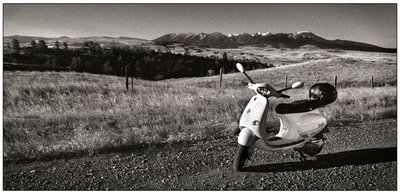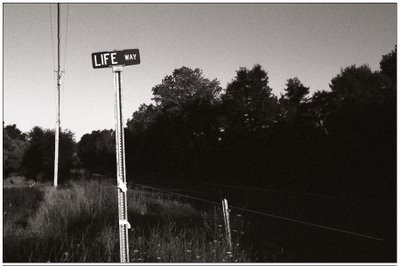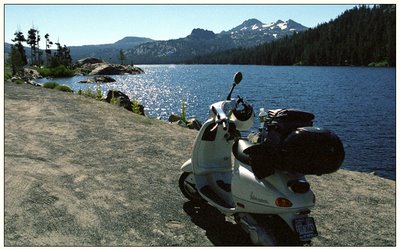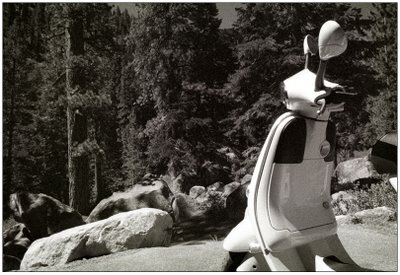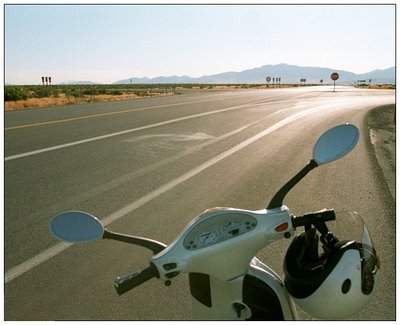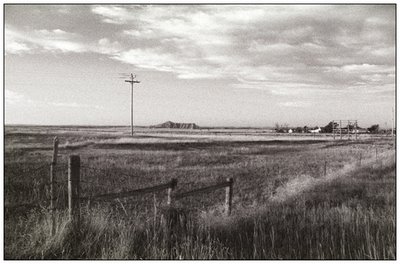Got an email from a chica who is planning to ride from Santa Cruz to Georgia on her Vespa 250. Here are the Q's she sent me, and my answers ~
Background Questions:How long did you have your Vespa before you went on your journey?I had it for a year. I rode exclusively in San Francisco proper - it would have been smart to do some day trips before the real thing; riding in the city makes for an awesome foundation but it takes different skills to ride long distances and on highways and byways.
How long did you plan for the trip itself?Two months? It all happened pretty fast but in a way that is a good thing. It's good to have a long time to plan something like this but I think if people give themselves TOO long to plan something (anything), it's easy to get caught up in the planning and re-planning and alternate-plan-planning and then it is never done, never lived.
Did you go on any long-ish trips to practice before you left?Nope. But I would recommend it, as per above!
Did you take a Motorcycle Safety Course, or did you just read a safety book?I had a private day lesson when I first got my Vespa from a guy who did biker safety courses for a living - he was fantastic. I never felt the need for anything additional while I was in the city. When I decided to go cross country, I read
Proficient Motorcycling which I cannot recommend enough. I've written about it
here.
I have a white helmet, which I also highly recommend. Yeah, they're generally dorkier than black ones, but SO much easier for other drivers to notice. When I got my Vespa, which is the iridescent pearl color, I bought a basic white helmet (3/4) and took it to the Vespa shop and they painted it to match my Vespa. So it wasn't quite as dorky as plain white. A sticker or awesome painted trim or something could also sex up a plain white helmet. If you don't already have a white helmet, keep your eye out when you're out and about - they are SO much easier to notice. And that goes a long way toward keeping you from getting hit.
Did you ever ride Hwy-1? What did you think?Never did! But that seems like the ideal type of road, to me - I took similar through the sierras and on the east coast. I was nervous about windey two-laners before setting out (because of driver error on the part of those who might share the road), but my worries were unfounded (though I stayed aware at all times, as anyone on two wheels should). The scenic highways generally have less traffic, and what traffic there is generally is there for the scenery and not in so much of a rush. And those roads are just incredible on two wheels, with the landscape right there, and the scents in the air, and the changes in temperature as you ride... it's heaven.
Gear Questions:Did you have any 'armor' under your jacket or pants, or was it just leather?I wore leather pants made by Alpine Stars (motorcycle gear) which had knee padding, and a really old leather biker jacket I had
(the old kind). So no real armor, though the leather was so thick I wasn't worried. Seems armor is more common in the nylon/fiber gear? I loved my leathers. Had no problem wearing them everyday for two months. Even stretching out on pavement at a gas station or on the side of the road was comfortable in those babies!
Any particular reason you chose that 'outfit'?It was relatively cheap - I had Harley boots that were free from a friend who worked at Harley and the jacket I had from highschool and so I just needed to buy the pants. And leather made more sense to me, for safety, durability, etc than any other biker pants. They were really warm when the air was cold, they were water resistant in light-to-moderate rain. They were super sexy which actually made me feel safer: the full black leather + sparkly little Vespa was incongruent. It wasn't a look that was immediately "figured out;" I looked more like a cartoon than an easy target. Although I didn't fully realize any of this till about Pennsylvania. :)
Did you bring any things that you found you didn't really need?No... but I packed really light ~
here is a post of what I brought.
Did you have a backpack on your back?NO. I think that would have been horrible.
Health/Food Questions:Did you just grocery shop a lot, or stop at restaurants - were you able to bring food along with you or did you buy it as you went?I bought as I went, but I kept a little stash on the Vespa - granola bars, apples, stuff like that. Stopped at grocery stores most of the time - cheaper and healthier - but also had my share of diner food. I spent a lot of nights with people - friends of friends or people I met along the way - which often meant really good food, too!
How did you have water handy?I think I had three water bottles that I'd fill from taps, campgrounds, people's houses. I made sure to drink A LOT. Even if I wasn't thirsty. Every time I pulled over, at stop signs, etc, I'd have some water.
Did you ever get really dehydrated and need to use the salt you brought along? Or just get sick in general?No, never did get sick or ill or anything.
Moving Questions:Did you ship your stuff out to New York? Any good company to look at for cheaply shipping some boxes? I'm trying to work out how to move my stuff. I don't have really any large items, just things that can go in boxes (and my bicycle).No. I ended up only being in NYC for a month, during which time I stayed with an ex-boyfriend, and then moved to Wyoming. So I flew back to CA, bought a truck, loaded what possessions I could fit, and drove to WY. I had my Vespa trucked out but I cannot remember the company. Before I left on the trip, I put my stuff in storage with a company that does shipping too - cannot remember the name either! But there are companies that give you like a month free storage and then they'll ship your stuff for a fee. That sort of thing is getting really common, so do your research and call companies to find the best price.
Did you ship changes of clothes, etc, to the places you stayed at for longer amounts of time - like your sister's house, or friend's?No. I just wore their clothes.
The Vespa Questions:What kind of Vespa did you have, and how many miles on it before you left?Mine is a Vespa ET4, 150cc. I have no idea how many miles I had on it when I left. I'm sure I have a photo somewhere..... You'll have more power and more packing space with the 250; I think the interstate will be possible for you on the 250, if you choose to take it, whereas I avoided it at all costs.
Did you have the original tires, or did you 'upgrade' before you left? What kind of Vespa preparation (maintenance, etc) did you do or have done before you left?I put new tires on right before I left - they were a bit of an upgrade but nothing super fancy - and had the tires replaced and a tune up at Scooterworks in Chicago.
Did you have any ideas of how to fix different things that might go wrong (basic understanding of the motor, etc)? Not really! I checked my tire pressure daily - blowing a tire was my biggest concern.
Did you have any concerns about putting that many miles on your Vespa in a few short months?No. I was curious but had faith in my machine. Others were skeptical. But I had zero trouble with the Vespa.
Did you get a list of Vespa dealers in the states you traveled through?Yes. This is easy to find online and I carried a list of their addresses and phone numbers. Never did need it, though.
The Trip Questions:Have you ever crashed/fallen off/somehow injured yourself or the Vespa?No.
Did you drive in any sort of inclement weather? What did you do when it rained?Yes. I rode in the rain many times, and when I was in the vicinity of Rochester, NY, they had the biggest rainstorm in documented history. Flooded the streets, I rode on the sidewalks when I could (you can't see potholes under several inches of water, which is no biggie for a car but bad on two wheels).
I stopped at laundromats twice that day to put my socks and shirts in the dryer, layered trash bags under my leathers (I didn't bring proper MC rain gear; it's bulky and I didn't think I'd need it that much, and in smaller rainstorms, the leather was just fine, this happened to be torrential - rain came in through my shoelace holes, under my helmet, everywhere).
I had SO much fun. But I made myself find a place to stay at around 2pm because I was soaked through for the nth time and thought it maybe wasn't the smartest thing to be wet and cold and riding with no windshield. It was so much fun though. I saw one other biker that day.
Riding in the wind was actually worse than riding in the rain. There was major wind in South Dakota and a few other stretches. It's hard to ride when it's coming crossways - takes muscle to stay in a straight line when your ride is light, - and when it's coming straight at you, it feels like you're being punched in the chest over and over. But I think the 250 maybe has a windshield? That would solve the chest punching issue. One other thing about rain - you don't have windshield wipers on a Vespa. I was constantly wiping my face shield with my glove while riding, in order to see.
How many hours a day did you ride, and did you ride only during certain hours of the day?It varied, based on where I was. In Nevada in August, I'd be on the road by 5am and end by early afternoon (when it's hottest). As I made my way east, it turned from summer to early autumn, and I'd start later in the day - 8 or 9am - because it was often very cold in the mornings and never as hot midday.
How often did you stop to take breaks during the day's ride?Often. I'd stop to eat, to gas up, to do jumping jacks if I was cold, to take photos. Stopping often kept me alert. And a lot of fun things happened when I stopped!
Did you ever have any problems with your Vespa - oil, tires, etc?Nope.
If you had to make a change in your route, did you have each state's map, or an atlas? How did you make sudden changes to your route? (I'm thinking of when you couldn't get past the buffalo and had to go another direction...)In that instance, I had the little free park map of the Black Hills on me, and could easily reference where I was and where I could go. Other times, I'd stop at a gas station and look at a local map or ask people.
Were you ever in a place where you worried that there wouldn't be a gas station in time, how did you make sure you never ran out of gas?The only time I was mildly concerned was along Highway 50 in Nevada, because towns are so few and far between. But I could get 100 miles on one tank, so I was fine. Other than Nevada, I filled up when the tank was half-full, just to stay on the safe side.
How did you know what the traffic would be like on the roads you chose (for example, how did you know a secondary highway wasn't traveled really heavily as well?)I didn't. Usually it was fine and often divine, but sometimes the traffic sucked. I can think of three stretches I really didn't enjoy: crossing the Diablos from the South Bay to Tracy, CA; Hwy 212/310 from Laurel, MT to the Wyoming state line (a road I still hate, even in a truck); and along lake Erie.
Did you have music, and if so, how did you listen to it?No! I really missed music. I sang a lot. Helmets have really awesome acoustics.
As I've begun to plan my route, I've started by looking at my Atlas, because I'm not a huge fan of staring at the computer screen. But I'm realizing that it's hard this way to know how long or short a route will be - is this why you used Google Earth?Yes. Atlases just don't work if you want the smaller roads. I hated mapping my trip - it was tedious and annoying, but I could find no other way, other than google maps. Maybe a GPS would do it? I did my trip before GPS was popular and affordable. Maybe?
I may have asked this in another question, but I'm interested in knowing how many miles you went (an average) during the day, and how many hours that took. Just to get a sense of how much longer this will take than in a car.I rode anywhere from 150 miles to 350 miles a day. 250 miles in a day was perfect. But, this was all off the interstate. Sometimes stretches of ten or twenty miles of dirt or gravel roads where I had to go like 15 miles an hour. On secondary highways, I enjoyed going 55 miles an hour. I'd say I averaged 35 or 40 miles an hour on any given day, so that would make a 250 mile day = seven hours of riding (not counting breaks for gas, food, chat, photos, exploring, naps, whatever). You'll have more options for speed on a 250, though.
What You Learned Questions:Have you since your trip thought of a better way to map your trip out, or do you think the way you did it was still how you'd do it again?As noted above, I'd explore the potential of a GPS - either to pre-plan or to bring with. If that failed, I'd have to stick with the original way I mapped it out.
There's probably a lot you learned about planning and executing a trip like this and I'm sure I don't even know the right questions, so anything you can share would be so appreciated.Don't worry too much! I didn't map the full trip before I left, just the segment from SF to Bozeman. I mapped out another length in Bozeman, then stopped at libraries along the way to map out further segments. So, it doesn't have to be done all at once. Public libraries are wonderful. You can use the computers for free, and it's good free shelter if you need it. Everyone I met wanted to help me. I got lost every day. I never felt scared.
And Finally, the Feelings Questions:Even starting to talk about this has brought a lot of feelings out from different people, and overwhelmingly people my age say 'oh that's so brave, go for it', and people older than me (or people really close to me like family) express lots of concern, and say it's a really bad idea, very dangerous, etc. Did you experience any fear that maybe it really was a bad idea, or that you were taking too many risks with your life? This is kind of a hard question to frame, because really, I'm just interested in your thought process during the planning stage when everyone was weighing in with their opinion on your decision.I know exactly what you mean. Only one person in my life at the time was supportive before I left. However, EVERYONE changed their tune when I was halfway across the country and proving my own success, which made me want to barf on them.
"Oh, my friend/daughter/whatever is doing this *amazing* thing...." when just weeks before they had been SO demeaning. So demeaning. It wasn't just concern, it was like, YOU'RE going to fuck this up. YOU will make a mistake and you will crash and get hit by a semi and get gang raped on the side of the road and it will be YOUR fault. I think some people feel the need to destroy other people who represent their own dreams that they let go.
As for the true, valid, compassionate concern ~ my answer to this (to others and to myself) is that "the bad things" could happen anywhere. I could wreck and lose a leg while riding in SF or even in a tiny, safe suburban neighborhood. Same with the gang rape. Same with any great fear anyone might have. Give yourself every reason to succeed with proper knowledge and confidence (not to be confused with cockiness), and then, why not go for it? Safety is an illusion. Another illusion is that you are ever
not safe. I say this because the things in my life that have seemed like the worst things at the time have proven to be the things I am most grateful for. It took the separate incidents of nearly dying and having my home burn down for me to grasp this, but it's now a truth for me.
This is not to say I was not nervous. I didn't shit for four days before I left (sorry for the TMI but is there any more blatant proof of nervousness?!) But, a week or two before I was set to leave, I was evaluating my feelings on the trip, and that VOICE - the voice in your head that says "don't go down that street" said, "Don't DON'T go." It was a double negative. It said GO. And I trusted that.
